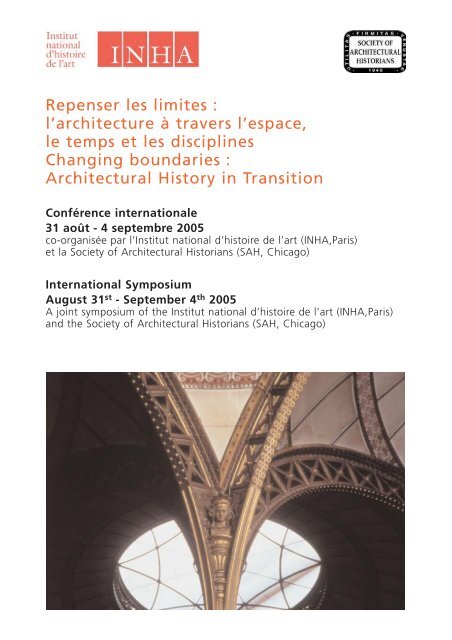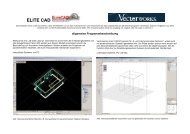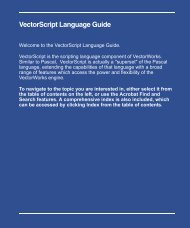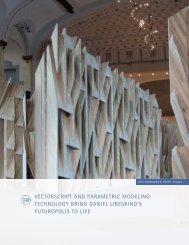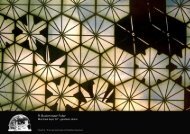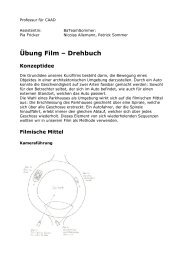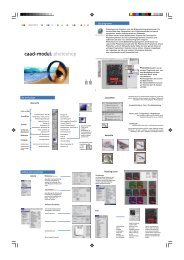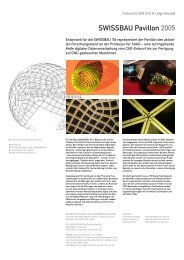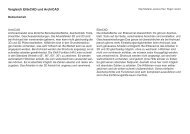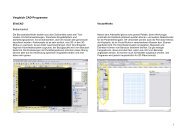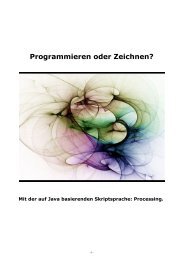Repenser les limites : l'architecture à travers l'espace ... - ETH Zürich
Repenser les limites : l'architecture à travers l'espace ... - ETH Zürich
Repenser les limites : l'architecture à travers l'espace ... - ETH Zürich
- No tags were found...
Create successful ePaper yourself
Turn your PDF publications into a flip-book with our unique Google optimized e-Paper software.
<strong>Repenser</strong> <strong>les</strong> <strong>limites</strong> :<br />
l’architecture à <strong>travers</strong> l’espace,<br />
le temps et <strong>les</strong> disciplines<br />
Changing boundaries :<br />
Architectural History in Transition<br />
Conférence internationale<br />
31 août - 4 septembre 2005<br />
co-organisée par l’Institut national d’histoire de l’art (INHA,Paris)<br />
et la Society of Architectural Historians (SAH, Chicago)<br />
International Symposium<br />
August 31 st - September 4 th 2005<br />
A joint symposium of the Institut national d’histoire de l’art (INHA,Paris)<br />
and the Society of Architectural Historians (SAH, Chicago)
Mercredi 31 août / Wednesday, August 31 st<br />
Chapitre européen de la SAH / SAH European Chapter<br />
Auditorium de l’INHA<br />
11 h 30 / Forum de discussion sur la création d’un Chapitre européen au sein de la<br />
11: 30 am Society of Architectural Historians /<br />
Forum about creating a SAH European Chapter<br />
Présidence / Chairs : Christine Mengin (Université de Paris I-Panthéon-<br />
Sorbonne, France), Rob Dettingmeijer (Universiteit Utrecht, Pays-Bas /<br />
Netherlands)<br />
Ateliers en parallèle / Satellite Sessions running concurrently<br />
1. Les nouvel<strong>les</strong> technologies appliquées à l’histoire de l’architecture /<br />
New Technologies and their Applications to Architectural History<br />
(en collaboration avec la / with the Direction de l’architecture et du patrimoine,<br />
Ministère de la Culture et de la Communication)<br />
Ministère de la Culture et de la Communication, 182 rue Saint-Honoré, 75001 Paris<br />
(M° Palais Royal)<br />
14 h / 2 pm Markus Schlicht (Centre d’études supérieures de civilisation médiévale,<br />
Poitiers, France)<br />
Histoire de l’architecture et informatique<br />
André Del, Pierre Lebigre, Evangelo Thomopoulos (Équipe de recherche<br />
“ Espace virtuel de conception architecturale et urbaine ”, Paris, France)<br />
Caravansérails et routes caravanières d’Asie centrale : inventaire de l’UNESCO<br />
et apport des technologies numériques<br />
Meredith Clausen (University of Washington, Seattle, USA)<br />
Cartographic systems and the history of architecture<br />
Bernd Kulawik (Berlin, Allemagne / Germany), Kaspar Zollikofer<br />
(Rome, Italie / Italy)<br />
Saint Peter’s in Rome beyond architecture. Crossing boundaries of countries<br />
and disciplines<br />
Amina Harzallah, Éric Monin, Daniel Siret (CERMA, École d’architecture<br />
de Nantes, France)<br />
Simulations et histoire de l’architecture : Controverse de l’axe héliothermique<br />
Ir Héctor Giro, Margit Tamàs (Technische Universiteit Delft, Pays-Bas /<br />
Netherlands)<br />
Digitalizing the Dutch. About interactivity versus boundaries and other<br />
ways to present and read architectural history<br />
Susanne Schumacher (Institut für Hochbautechnik-Eidgenössische<br />
Technische Hochschule Zürich, Suisse / Switzerland)<br />
Order of Columns revisited. XML in the History of art and architecture
2. Fortune, infortune de l’architecture / Fortune, misfortune of Architecture<br />
Reid Hall, Columbia University, 4 rue de Chevreuse, 75006 Paris (M° Vavin)<br />
Présidence / Chairs : François Loyer (Département d’histoire de l’architecture<br />
et d’archéologie de la Ville de Paris, France), Jean Castex (LADRHAUS,<br />
École d’architecure de Versail<strong>les</strong>, France)<br />
14 h / 2 pm Franca Malservisi (Université de Saint-Quentin-en-Yvelines – École d’architecure<br />
de Versail<strong>les</strong>, France)<br />
L’historiographie, la réception et la restauration de deux architectures des<br />
années 1730 : la fontaine du Gros-Horloge à Rouen et la façade de l’Ancienne<br />
Comédie à Avignon<br />
Raphaël Labrunye (Université de Saint-Quentin-en-Yvelines – École d’architecture<br />
de Versail<strong>les</strong>, France)<br />
Historiographie d’une icône de l’architecture moderne, l’orphelinat d’Amsterdam<br />
d’Aldo Van Eyck<br />
Jean-Char<strong>les</strong> Cappronnier (Université de Saint-Quentin-en-Yvelines – École<br />
d’architecure de Versail<strong>les</strong>, France)<br />
Le discours contextuel sur la production architecturale de Char<strong>les</strong> Duval<br />
(1873-1937) et Emmanuele Gonse (1880-1954) : entre devoir intellectuel et<br />
nécessité matérielle<br />
Manolita Fréret-Filippi (Département d’histoire de l’architecture et<br />
d’archéologie de la Ville de Paris, France)<br />
La perception de la pratique architecturale en province à la fin du XIX e siècle :<br />
le “ cas ” Camille Albert (1852-1942), architecte de la ville de Fécamp<br />
Alexis Markovics (Université de Saint-Quentin-en-Yvelines – École d’architecture<br />
de Versail<strong>les</strong>, France)<br />
La fortune d’une production ordinaire : <strong>les</strong> immeub<strong>les</strong> parisiens d’un<br />
entrepreneur, Albert-Joseph Sélonier (1858-1926)
Présentation de la Cité de l’architecture et du patrimoine /<br />
Presentation of the Cite de l’architecture et du patrimoine<br />
Salle de séminaire de l’INHA / Seminar room, INHA<br />
14 h / 2 pm François de Mazières (Cité de l’architecture et du patrimoine, Paris, France)<br />
Les publics et <strong>les</strong> missions de la Cité<br />
Marie Paule Arnauld (Cité de l’architecture et du patrimoine, Paris, France)<br />
Le Musée des monuments français, rénovation et extension<br />
Odile Welfele (Cité de l’architecture et du patrimoine, Paris, France)<br />
La galerie des moulages<br />
Robert Dulau (Cité de l’architecture et du patrimoine, Paris, France)<br />
La galerie des peintures mura<strong>les</strong><br />
Corinne Bélier (Cité de l’architecture et du patrimoine, Paris, France)<br />
La galerie d’architecture moderne et contemporaine<br />
David Peycéré (Archives d’architecture du XX e siècle-Institut français<br />
d’architecture, Cité de l’architecture et du patrimoine, Paris, France)<br />
Le Centre d’archives de l’Institut français d’architecture<br />
Réception / Reception<br />
Reid Hall, 4 rue de Chevreuse, 75006 Paris (M° Vavin)<br />
18 h / 6 pm Ouverte à tous <strong>les</strong> participants au colloque /<br />
Open to all symposium participants
Jeudi 1 er septembre / Thursday, September 1 st<br />
Limites territoria<strong>les</strong> / Spatial Boundaries<br />
Session plénière / Plenary Session<br />
Auditorium de l’INHA<br />
Présidence / Chair : Eve Blau (Harvard University, Cambridge, Mass.,<br />
USA)<br />
9 h / 9 am Saundra Weddle (Drury University, USA)<br />
The Ritual Frame and the Limits of Spatial Enclosure in the Early Modern City<br />
Krista De Jonge (Katholieke Universiteit Leuven, Belgique / Belgium)<br />
Shifting Alliances, Shifting Artistic Boundaries Reassessing Netherlandish<br />
Architecture of the Late Middle Ages and Early Modern Period and its<br />
geographical context<br />
Jean Guillaume (Université de Paris IV-Sorbonne, France)<br />
Les frontières de la Renaissance : obstacle ou chance <br />
Greg Hise (University of Southern California, Los Ange<strong>les</strong>, USA)<br />
The State in architectural History : how its strategies and practices define Space<br />
and direct Design<br />
Tom Mc Donough (State University of New York at Binghampton,<br />
New York, USA)<br />
The Geography of Abstraction : City, Territory and Economic Mapping<br />
Talinn Grigor (Massachusetts Institute of Technology, Cambridge, USA)<br />
Of Aryan Origin(s), Western Canon(s) and Iranian Modernity<br />
Ateliers en parallèle / Satellite Sessions running concurrently<br />
Sal<strong>les</strong> de séminaire de l’INHA / Seminar rooms, INHA<br />
1. Ambivalent Geographies : Situating Difference in Architectural History /<br />
Complexité des géographies : situer <strong>les</strong> différences en histoire de l’architecture<br />
Présidence / Chairs : Elvan Altan Ergut ( Middle East Technical University,<br />
Ankara, Turquie / Turkey), Belgin Turan Özkaya (Middle East Technical<br />
University, Ankara, Turquie / Turkey), Dana Arnold (School of Humanities,<br />
University of Southampton, UK)<br />
14 h / 2 pm Introduction<br />
S. M. Can Bilsel (University of San Diego, USA)<br />
Imagined Geographies : Reflections on the Official Representations of the<br />
Orient in Berlin under the Wilhelmine Empire
Sevil Enginsoy Ekinci (Middle East Technical University, Ankara, Turquie /<br />
Turkey)<br />
Building as a Machine / Commodity : Consumption / Production of a<br />
19 th Century Ottoman / British “ Iron House for a Corn-Mill ”<br />
Elvan Altan Ergut<br />
Travelling Words and Images : The Question of “ Foreignness ” add in The<br />
History of Modern Architecture in Turkey<br />
Patricia Morton (University of California, Riverside, USA)<br />
The Uses and Abuses of Human Geography : Difference and Space at World’s<br />
Expositions<br />
Alona Nitzan-Shiftan (Faculty of Architecture and Town Planning, Haïfa,<br />
Israël / Israel)<br />
Criticizing the Modern Movement in Post’67 Jerusalem : A Testing<br />
Ground for Inter-Cultural Reading<br />
Belgin Turan Özkaya<br />
Concluding remarks<br />
2. Spatial structures in colonial Latin America, new perspectives in architectural<br />
and urban historiography / Structures territoria<strong>les</strong> des colonies d’Amérique latine :<br />
nouvel<strong>les</strong> perspectives historiographiques en architecture et urbanisme<br />
Présidence / Chair : Catherine Ettinger (Universidad Michoacana de San<br />
Nicolas de Hidalgo, Mexique / Mexico)<br />
14 h / 2 pm Guadalupe Salazar-González (Universidad Autónoma de San Luis Potosí,<br />
Mexique / Mexico)<br />
L’espace construit en Amérique latine coloniale. Nouvel<strong>les</strong> perspectives pour<br />
son étude<br />
Eugenia Maria Azevedo Salomao (Universidad Michoacana de San Nicolás<br />
de Hidalgo, Morelia, Mexique / Mexico), Catherine Ettinger<br />
Indigeneous contributions to City Planning in New Spain<br />
Marilia M. Brasileiro Teixeira Vale (Universidade Federal de Uberlandia,<br />
Brésil /Brazil), Andrey Rosenthal Schlee (Universidade de Brasilia, Brésil /<br />
Brazil)<br />
Settlements for indigeneous population in Portuguese America, Morphology<br />
and Permanence<br />
Luis María Calvo, Adriana Collado et Luís Alberto Müller (Universidad<br />
Nacional del Litoral, Argentine / Argentina)<br />
Colonial Settlements of Rio de la Plata Region : between the transference and<br />
the development of Hispanic urban model<br />
Alberto Nicolini (Universidad Nacional de Tucumán, Argentine / Argentina)<br />
Colonial Settlement Planning of the Andes in space and time
3. Socialist architecture between isolation and fascination / Architecture socialiste,<br />
entre isolement et fascination<br />
Présidence / Chair : Carmen Popescu (Centre de recherche André Chastel,<br />
CNRS, France)<br />
14 h / 2 pm David Crowley (Royal College of Art, London, UK)<br />
Modern Architecture and Socialist Leisure in Warsaw in the 1950’s<br />
Simone Hain (Bauhaus Universität Weimar, Allemagne / Germany)<br />
Twin and Foe : Postwar Architecture in the two Germanies<br />
Andres Kurg (Estonian Academy of Art, Tallinn, Estonie / Estonia)<br />
Constructivism revisited. The Case of the “ Golden Home ” in 1970’s Estonia<br />
Juliana Maxim (University of San Diego, USA)<br />
Writing Histories of architecture in 1960’s Europe : The Romanian case<br />
Eduardo Luis Rodriguez (Docomomo Cuba, Director de la revista<br />
Arquitectura Cuba, Havana, Cuba)<br />
On Symbolism and Ideology in Cuban Architecture in the 1960’s<br />
Charity Scribner (Massachusetts Institute of Technology, Cambridge, USA)<br />
The Other Europe of Joseph Beuys : Surveying the Fallout of State Socialism<br />
4. Dynamiques transnationa<strong>les</strong> : nouvel<strong>les</strong> approches de la modernité et des terrains<br />
coloniaux / Transnational dynamics : new apprehensions of Modernity and colonies<br />
Présidence / Chair : Mercedes Volait (laboratoire CITERES, CNRS, Tours,<br />
France)<br />
14 h / 2 pm George Arbid (American University in Beirut, Liban / Lebanon)<br />
Interactions et effets locaux : à propos de quelques architectes européens au Liban<br />
Sheila Crane (University of California, Santa-Cruz, USA)<br />
Architecture in Translation between Marseille and Algiers<br />
Marie-Laure Crosnier-Leconte (Institut national du patrimoine-Direction<br />
des musées de France, Paris, France)<br />
Les grands concours internationaux (1890-1914) : vecteurs parallè<strong>les</strong> de<br />
diffusion de l’architecture française <br />
June Komisar (Ryerson University, Toronto, Canada)<br />
Looking at collaboration as a key to creative expression : the case of colonial<br />
architecture in Minas Gerais, Brazil<br />
Johan Lagae (Universiteit Gent, Belgique / Belgium)<br />
Conflicting memories. Documenting and analyzing colonial heritage in<br />
the former Belgian Congo<br />
Jean Baptiste Minnaert (Université François Rabelais, Tours, France)<br />
Étudier l’architecture et la ville de la Méditerranée contemporaine dans une<br />
posture multilatérale : état des savoirs et perspectives<br />
Joe Nasr (Institut Français du Proche Orient, Beyrouth, Liban / Lebanon)<br />
Actors and vectors : towards alternate histories of the city-building process
Mercedes Volait<br />
Chassés-croisés transnationaux : remarques généra<strong>les</strong> et illustrations égyptiennes<br />
Discussion : Catherine Bruant (LADRHAUS, École d’architecture de<br />
Versail<strong>les</strong>, France)<br />
5. Espaces, rituels, pratiques / Spaces, Rituals, Practices<br />
Présidence / Chair : Frank Salmon (Paul Mellon Centre for Studies in<br />
British Art, London, UK)<br />
14 h / 2 pm Monique Chatenet (Centre de recherche André Chastel, CNRS, Paris, France)<br />
Architecture et diplomatie : rencontre au sommet de Louis XII et Philippe<br />
Le Beau à Blois en décembre 1501<br />
Naomi Miller (Boston University, USA)<br />
A Sense of Place : a Treatise on Prostitution in the 17 th Century<br />
David Walter Booth (Université de Montréal, Canada)<br />
Canon Law and the Centrally-Planned Church (1400-1750)<br />
Judy Loach (Cardiff University, UK)<br />
Spatial Boundaries to and in 17 th Century France<br />
Barbara Arciszewska (University of Warsaw, Pologne / Poland)<br />
Golden Age for a changing nation : Polish national identity and the histories<br />
of Wilanow residence of King Jan III Sobieski<br />
Anne Troutman, (University of California, Los Ange<strong>les</strong>, USA)<br />
“ Voluptuous Space ” : The language of the Boudoir<br />
Conférence plénière / Plenary lecture<br />
Auditorium de l’INHA<br />
19 h / 7 pm Alain Schnapp (directeur général de l’INHA / Historian of Art and<br />
Archeologist, Director of the INHA)<br />
La pierre, la brique et <strong>les</strong> mots : Princes et poètes dans l’Orient ancien
Vendredi 2 septembre / Friday, September 2 nd<br />
Limites temporel<strong>les</strong> / Temporal Boundaries<br />
Session plénière / Plenary Session<br />
Auditorium de l’INHA<br />
Présidence / Chair : Carlos Sambricio (Universidad Politecnica de Madrid,<br />
Espagne / Spain)<br />
9h30/ Martine Jullian (Université de Grenoble II, France)<br />
9: 30 am Les temps de l’architecture à l’époque gothique dans <strong>les</strong> Alpes occidenta<strong>les</strong><br />
Nasser Rabbat (Massachusetts Institute of Technology, Cambridge, USA)<br />
Towards an Intercultural Historiography of Islamic Architecture<br />
Claude Mignot (Université de Paris IV-Sorbonne, France)<br />
Le temps n’a pas de frontières : le cas de l’histoire de l’architecture française<br />
(1570-1670)<br />
Jean-Philippe Garric (École d’architecture de Paris-Belleville, France)<br />
Le néoclassicisme n’est pas un classicisme. Une mutation dans <strong>les</strong> livres<br />
d’architecture<br />
Stefan Muthesius (University of East Anglia, Norwich, UK)<br />
19 h Century Architectural History : History before and after Authenticity<br />
Henrik Widmark (Uppsala Universitet, Suède / Sweden)<br />
Disregarding Berlin Emblematic City Space and Architecture in Everyday Use<br />
Ateliers en parallèle / Satellite Sessions running concurrently<br />
Sal<strong>les</strong> de séminaire de l’INHA / Seminar rooms, INHA<br />
1. <strong>Repenser</strong> <strong>les</strong> <strong>limites</strong> temporel<strong>les</strong> : l’histoire de l’architecture et le défi du patrimoine<br />
moderne / Rethinking temporal boundaries : History of Architecture and the Challenge<br />
of Modern Heritage<br />
Présidence / Chair : Maristella Casciato (Docomomo International, Paris,<br />
France), France Vanlaethem (Université du Québec à Montréal, Canada)<br />
14 h / 2 pm Gérard Monnier (Université de Paris I-Panthéon-Sorbonne, France)<br />
Temps court et temps long : l’édifice-événement, un problème pour l’histoire<br />
Réjean Legault (École de Design, Université du Québec à Montréal, Canada)<br />
L’architecture des années 60 : quand l’histoire est dépassée par le patrimoine<br />
Hilde Heynen (Katholieke Universiteit Leuven, Belgique / Belgium)<br />
Questioning Authenticity<br />
Lazare Eloundou (Centre du patrimoine mondial de l’UNESCO, Paris, France)<br />
Éclairages culturels du patrimoine moderne : le contexte africain<br />
Bernard Toulier (Ministère de la Culture et de la Communication, Paris, France)<br />
Les enjeux du patrimoine du XX e siècle en France
2. Architecture et archéologie à la Renaissance / Architecture and Archeology<br />
during the Renaissance<br />
Présidence / Chair : Frédérique Lemerle (Centre d’études supérieures de<br />
la Renaissance, CNRS, Tours, France)<br />
14 h / 2 pm Felipe Pereda (Universidad Autonoma de Madrid, Espagne / Spain)<br />
The Origin of Cubic Architecture : Reconstructions of Solomon’s Temple in 15 th<br />
Century Spain<br />
Hubertus Günther (Kunsthistorisches Institut der Universität Zürich,<br />
Suisse / Switzerland)<br />
Les débuts de la science moderne : <strong>les</strong> études antiquaires à la Renaissance en Italie<br />
Adriano Ghisetti Giavarina (Università degli Studi G. d’Anunzio-Chieti -<br />
Pescara, Italie / Italy)<br />
Palladio et <strong>les</strong> antiquités de l’Ombrie à la Renaissance<br />
Pierre Gros (Institut universitaire de France – Université d’Aix-en-Provence,<br />
France)<br />
Palladio et la maison selon Vitruve<br />
Anna Schreurs-Morét (Universität Frankfurt am Main, Allemagne / Germany)<br />
Études de l’antiquité à Nap<strong>les</strong> : le temple des Dioscures vu par Pirro Ligorio<br />
Frédérique Lemerle<br />
Les Français et <strong>les</strong> antiquités de la Gaule : l’émergence de la conscience<br />
antiquaire<br />
3. La configuration architecturale de la ville et de sa périphérie au Moyen Âge :<br />
la dynamique des <strong>limites</strong> / Architectural structure of cities and their peripheries<br />
during the Middle Ages : Dynamic Boundaries<br />
Présidence / Chairs : Brigitte Boissavit (Université Paris X-Nanterre,<br />
France), Panayota Volti (Université Paris X-Nanterre, France)<br />
14 h / 2 pm Thomas Coomans (Katholieke Universiteit Leuven, Belgique / Belgium)<br />
Les béguinages, établissements féminins périurbains<br />
Floriane Louis (Université Paris IV-Sorbonne, France)<br />
Le Vicariat de Pontoise : reflets de l’architecture défensive en milieu urbain à<br />
la fin du Moyen Âge<br />
Dominique Massounie (Université Paris X-Nanterre, France)<br />
La ville médiévale et ses <strong>limites</strong> vues par <strong>les</strong> architectes modernes<br />
Alain Salamagne (Université François-Rabelais, Tours, France)<br />
Pouvoir souverain, pouvoir urbain : <strong>les</strong> enjeux d’une restructuration urbaine<br />
(XV e -XVII e sièc<strong>les</strong>)
4. Sty<strong>les</strong> et périodisation : méthodes croisées dans l’approche<br />
de l’architecture des XVIII e et XIX e sièc<strong>les</strong> / Sty<strong>les</strong> and periodisation : inter-related<br />
methodologies for understanding 18 th and 19 th Centuries Architecture<br />
Présidence / Chairs : Jean-Michel Leniaud (École pratique des hautes<br />
études, Paris, France), Daniel Rabreau (Centre Ledoux, Université de Paris I-<br />
Panthéon-Sorbonne, France)<br />
14 h / 2 pm Daniel Rabreau<br />
Méthodologie du Goût à la grecque sous Louis XV<br />
Edoardo Piccoli (Politecnico di Turino, Italie / Italy)<br />
Jean-François Blondel à l’apogée, 1749-1756<br />
Basile Baudez (École pratique des hautes études, Paris, France)<br />
Un laboratoire des sty<strong>les</strong> : <strong>les</strong> académies dans la seconde moitié du XVIII e siècle<br />
Jean-Michel Leniaud<br />
De la rupture au progrès (1840-1860)<br />
Esteban Castaner Munoz (Université de Perpignan, France)<br />
Une option stylistique minoritaire : le néo-arabe à <strong>travers</strong> l’architecture des<br />
hal<strong>les</strong> métalliques en Espagne au XIX e siècle<br />
Lorraine Decléty (École pratique des hautes études, Paris, France)<br />
L’orientalisme, entre connaissance et réinterprétation de l’architecture islamique<br />
5. <strong>Repenser</strong> le XIX e siècle : reflets du débat européen sur l’Italie /<br />
Rethinking the 19 th Century : Italy and European debates<br />
Présidence / Chairs : Vilma Fasoli (Facoltà di Architettura dell’Università<br />
degli Studi di Trieste, Italie / Italy), Elisabetta Pallottino (Facoltà di<br />
Architettura dell’Università degli Studi Roma Tre, Italie / Italy)<br />
14 h / 2 pm Gian Paolo Consoli (Facoltà di Ingegneria del Politecnico di Bari, Italie / Italy)<br />
Beyond the 19 th Century : Roma Capitale, Mutations of Symbolic Buildings,<br />
from Competitions to Inaugurations (1880-1911)<br />
Maurizio Ghelardi (Scuola Normale Superiore di Pisa, Italie / Italy)<br />
Franz Kugler, Carl Schnaase and Jacob Burckhardt, interpreters of the<br />
Renaissance architecture in Italy<br />
Olivia Noël, (Facoltà di Architettura dell’Università degli Studi Roma Tre,<br />
Italie / Italy)<br />
Moyen Âge et Renaissance au passé et au présent : la restauration à Rome au<br />
XIX e siècle (1781-1938)<br />
Ornella Selvafolta (Facoltà di Ingegneria Edile-Architettura del Politecnico<br />
di Milano, Italie / Italy)<br />
The image of the Renaissance in 19 th Century architecture and decorative arts<br />
periodicals : the spreading, use and abuse of a national legacy
Marida Talamona (Facoltà di Architettura dell’Università degli Studi Roma Tre,<br />
Italie / Italy)<br />
Un thème urbain de longue durée : projets et programmes du XIX e siècle pour<br />
Saint-Pierre et la Spina di Borgo<br />
Francesca Torello (Facoltà di Architettura 2 del Politecnico di Torino,<br />
Italie / Italy)<br />
Spécialisation des disciplines et enseignement de l’Antiquité : glissements du<br />
centre de gravité entre Vienne et l’Italie<br />
Guido Zucconi (Istituto Universitario di Architettura di Venezia,<br />
Italie / Italy)<br />
La construction en voûte, paradigme pour <strong>les</strong> historiens et modèle pour <strong>les</strong><br />
bâtisseurs (1850-1890)<br />
6. Histoire, Historiens / History, Historians<br />
Présidence / Chair : Jean-Louis Cohen (Institute of fine Art / New York<br />
University, New York, USA)<br />
14 h / 2 pm Aron Vinegar (Ohio State University, USA)<br />
Viollet-le-Duc and the dream Navel of historicism<br />
Antonio Brucculeri (Università di Padoua, Italie / Italy)<br />
Stratégies éditoria<strong>les</strong> et architectures de l’histoire : Louis Hautecœur et Gérard<br />
Van Oest, un dessein partagé<br />
Ariyuki Kondo (Seigakuin University, Japon / Japan)<br />
The Triumph of Nikolaus Pevsner : Overcoming Disciplinary Boundaries in<br />
the History of Architecture<br />
Reto Geiser (Institut für Geschichte und Theorie der Architektur-<strong>ETH</strong>,<br />
Zürich, Suisse / Switzerland)<br />
Looking Forward Through the Rearview Mirror : Tracing Sigfried Giedion’s<br />
Historiography<br />
Mardges Bacon (Northeastern University, Boston, USA)<br />
Architecture, regionalism, and the Vernacular : Reconceptualizing Modernism<br />
in America<br />
Nigel Whiteley (Lancaster University, UK)<br />
Fits environments, ecologies and expanded fields : changing boundaries<br />
in the late 1960’s<br />
Jorge Otero-Pailos (Columbia University, New York, USA)<br />
Phenomenology and the Rise of the Architect as Historian
Visite / Tour<br />
Quadrilatère Richelieu (Bibliothèque nationale de France-INHA)<br />
58 rue de Richelieu, 75002 Paris (M° Bourse / Palais Royal)<br />
18 h / 6 pm Visite des lieux historiques du site Richelieu de la Bibliothèque nationale de<br />
France et présentation de documents d’architecture conservés à la Bibliothèque<br />
nationale de France et à la bibliothèque de l’INHA-collections Jacques Doucet<br />
dans la salle ovale. /<br />
Tours of historical buildings of the French National Library on its rue de<br />
Richelieu site. Commented tour of the display of architectural documents<br />
from the French National Library and the Library of the INHA-collections<br />
Jacques Doucet in the “ salle ovale ” reading room.<br />
Soirée / Evening<br />
20 h / 8 pm Dîner dans l’ancienne salle de lecture de la Bibliothèque nationale de France<br />
édifiée par Henri Labrouste entre 1860 et 1868. /<br />
Dinner in the former reading room of the French National Library built by<br />
Henri Labrouste (1860-1868).
Samedi 3 septembre / Saturday, September 3 rd<br />
Limites disciplinaires / Disciplinary Boundaries<br />
Session plénière / Plenary Session<br />
Auditorium de l’INHA<br />
Présidence / Chair : Roland Recht (Collège de France, Paris, France)<br />
9 h / 9 am Nicolas Reveyron (Université Louis Lumière-Lyon 2, France)<br />
Histoire de l’architecture et archéologie du bâti : l’interdisciplinarité au<br />
cœur de l’édifice<br />
Hervé Brunon, Monique Mosser (Centre de recherche André Chastel,<br />
CNRS, Paris, France)<br />
L’enclos comme parcelle et totalité du monde : pour une approche holistique de<br />
l’art des jardins<br />
Juan Calatrava (Universidad de Grenada, Espagne / Spain)<br />
Le Romantisme espagnol et l’historiographie de l’architecture<br />
Jorge Liernur (Universidad Torcuato Di Tella, CONICET, Buenos Aires,<br />
Argentine / Argentina)<br />
Ornament and Racism : Anthropological Prejudices in Adolf Loos’s Foundations<br />
of Modern Architecture<br />
Laurent Baridon (Université Marc Bloch-Strasbourg II, France)<br />
Le corps, pour une approche anthropologique de l’architecte<br />
Carlo Olmo, Michela Comba (Politecnico di Torino, Italie / Italy)<br />
L’histoire de l’architecture : un matériau complexe. Discussion sur son<br />
historiographie<br />
Ateliers en parallèle / Satellite Sessions running concurrently<br />
Sal<strong>les</strong> de séminaire de l’INHA / Seminar rooms, INHA<br />
1. Urban Design History as an Interdisciplinary Field : Working across Boundaries<br />
in the Formative Years 1890-1940 / L’histoire de l’urbanisme comme domaine interdisciplinaire<br />
: franchissements de frontières dans <strong>les</strong> années de formation (1890-1940)<br />
Présidence / Chair : Wolfgang Sonne (University of Strathclyde, Glasgow, UK)<br />
14 h / 2 pm Christiane Crasemann Collins (West Falmouth, Massachusetts, USA)<br />
Hegemann and Eberstadt - Economists focus on Housing as an Integral<br />
Component of Urban Planning<br />
Volker Welter (University of California, Santa Barbara, USA)<br />
Geddes - Biology as a Paradigm<br />
Nancy Stieber (University of Massachusetts, Boston, USA)<br />
Berlage - Visualizing History and Cities
Iain Boyd Whyte (University of Edinburgh, UK)<br />
Spiritual Aspects and Ideas in Urban Design<br />
Diana Periton (Glasgow School of Art, UK)<br />
Fact and Fiction - Literature and the Development of Urban Design History<br />
Wolfgang Sonne (University of Strathclyde, Glasgow, UK)<br />
The Birth of Urban Design History out of the Spirit of Interdisciplinarity<br />
Vittorio Magnago Lampugnani (Institut für Hochbautechnik - Eidgenössische<br />
Technische Hochschule Zürich, Suisse / Switzerland)<br />
Urban Design and the System of Influencing Factors<br />
Ulrich Maximilian Schumann (Polis Urban Consulting, Karlsruhe, Allemagne /<br />
Germany)<br />
Interdisciplinary Consultancy for Urban Design<br />
2. Histoire de l’architecture et mise en valeur du patrimoine : pour un dialogue<br />
entre restaurateurs et économistes / History of Architecture and valorizing Heritage :<br />
discussions between Heritage specialists and economists<br />
Présidence / Chair : Christine Mengin (Université de Paris I-Panthéon-<br />
Sorbonne, France)<br />
14 h / 2pm Alain Godonou (École du Patrimoine africain, Bénin / Benin)<br />
Le projet de réhabilitation de Porto-Nevo (Bénin) : objectifs en termes de<br />
conservation et de développement durable<br />
Catherine Mathieu (Facultade de Campinas, Brésil / Brazil)<br />
La rénovation des centres historiques brésiliens (Programme Monumenta) :<br />
objectifs socio-économiques et urbains<br />
Réactions aux exemp<strong>les</strong> béninois et brésiliens<br />
Marina Galvani (World Bank, Washington, USA)<br />
Les banques de développement et l’harmonisation des critères économiques et<br />
patrimoniaux : réflexions à partir des exemp<strong>les</strong> présentés<br />
Michel Vernières (Université Paris I-Panthéon-Sorbonne – Haut Conseil<br />
de Coopération Internationale, administrateur du GEMDEV, France)<br />
Le point de vue de l’économie du développement<br />
Bernard Morucci (Université de Paris I-Panthéon-Sorbonne – Chaire UNESCO<br />
de Tourisme culturel, Paris, France)<br />
Le point de vue du tourisme culturel<br />
Léo Orellana (SIRCHAL - séminaires internationaux sur la revitalisation<br />
des centres historiques dans <strong>les</strong> vil<strong>les</strong> d’Amérique latine et des Caraïbes,<br />
Direction de l’architecture et du patrimoine – Agence française d’action<br />
artistique, France / Chili)<br />
Le point de vue de l’architecte<br />
Conclusion : Marie Berducou (Université de Paris I-Panthéon-Sorbonne,<br />
France), Denis Guillemard (Université de Paris I-Panthéon-Sorbonne,<br />
France)
3. South African Architectural after Apartheid / Histoire de l’architecture de l’Afrique<br />
du Sud après l’Apartheid<br />
Présidence / Chairs : Hannah Le Roux (School of Architecture and<br />
Planning-University of Witwaterstrand, Johannesburg, Afrique du Sud /<br />
South Africa), Diane Ghirardo (University of Southern California, USA)<br />
14 h / 2 pm Jonathan Noble (University of the Witwatersrand, Johannesburg, Afrique<br />
du Sud / South Africa)<br />
Architecture Hybridity and Post-Apartheid Design<br />
Jennifer Beningfield (Openspace architects, London, UK)<br />
The South African landscape : Image and representation in the 20 th Century<br />
Zayd Minty (District Six Museum, Cape Town, Afrique du Sud /<br />
South Africa)<br />
Putting the Heart back into Cape Town’s central city : The struggle for<br />
District Six in 2005<br />
Federico Freschi (University of the Witwatersrand, Johannesburg, Afrique<br />
du Sud / South Africa)<br />
Imagining Unity : The construction of an imaginary of “ unity in diversity ”<br />
in the decorative programmes of recent South African public buildings<br />
Sabine Marschall (University of Kwazulu-Natal, Afrique du Sud /<br />
South Africa)<br />
Reordering the Past : Monuments and Architectural Heritage in<br />
Post-Apartheid South Africa<br />
Nina Cohen (architect, Johannesburg, Afrique du Sud / South Africa)<br />
Four Projects by Cohen & Judin
4. The 1970’s : Designing Futures, Community and Technology in Architecture and<br />
Urban Design / Les années 70 : penser le futur, la communauté et la technologie<br />
en architecture et en urbanisme<br />
Présidence / Chair : Paul Walker (University of Melbourne, Australie /<br />
Australia)<br />
14 h / 2 pm Paul Walker<br />
The Management of Meaning : Semiotics in 1970’s Architecture<br />
Sandra Kaji-O’Grady (University of Technology, Sydney, Australie /<br />
Australia)<br />
The London Conceptualists : Then and Now<br />
Tom Avermaete (Instituute von Architectuur Antwerpen–Katholieke<br />
Universiteit Leuven, Belgique / Belgium)<br />
Building a Thousand Youth Clubs : Technology and the rejuvenation of France<br />
(1966-1978)<br />
Mary Louise Lobsinger (University of Toronto, Canada)<br />
The Politics of Aesthetic Withdrawal in Italian Neo-Avant-Gardism<br />
Felicity Scott (University of California, Irvine, USA)<br />
Shooting Apocalypse<br />
Florian Urban (Technische Universität, Berlin, Allemagne / Deutschland–<br />
Massachussets Institute of Technology, Cambridge, USA)<br />
Kisho Kurokawa and Japan in the 70’s<br />
5. Questioning the disciplinary boundaries of Early<br />
Modern Architecture in Italy / Reconsidérer <strong>les</strong> frontières disciplinaires<br />
de l’architecture du XVI e et XVII e sièc<strong>les</strong> en Italie<br />
Présidence / Chair : Caroline Van Eck (Universiteit Groningen,<br />
Pays-Bas / Netherlands)<br />
14 h / 2 pm Indra Kagis McEwen (Concordia University, Montréal, Canada)<br />
Vitruvius at the Rubicon<br />
Maarten Delbeke (Universiteit Gent, Belgique / Belgium)<br />
Architecture and the genres of History writing in ecc<strong>les</strong>iastical Historiography<br />
Lionel Devlieger (Universiteit Groningen, Pays-Bas / Netherlands)<br />
Deconstructing the doctrine of disegno<br />
Ingo Herklotz (Philipps-Universität Marburg, Allemagne / Germany)<br />
Pagan or Christian : Continuity and opposition in Counter-Reformation<br />
considerations of Roman Architecture
6. Architecture, sciences, sciences humaines / Architecture, Sciences, Human Sciences<br />
Présidence / Chair : David van Zanten (Northwestern University,<br />
Evanston, IL., USA)<br />
14 h / 2 pm Yves Pauwels (Centre d’études supérieures de la Renaissance, CNRS –<br />
Université François Rabelais, Tours, France)<br />
Architecture, rhétorique et création littéraire au XVI e siècle<br />
Robert Carvais (CNRS–Université de Panthéon Assas-Paris II, France),<br />
Dirk Van de Vijver (Katholieke Universiteit Leuven, Belgique / Belgium)<br />
Architecture et droit : mimesis théoriques et liaisons pratiques<br />
Pierre Pinon (École d’architecture de Paris-Belleville – INHA, France)<br />
L’inadaptation des <strong>limites</strong> géographiques et historiques, comme reflet d’une<br />
confusion des <strong>limites</strong> disciplinaires<br />
Joao Magalahaes Rocha (Universidade do Minho, Portugal)<br />
John Desmond Bernal and the British Interwar period : Interrelationship<br />
between Art and Science in the eve of the 30’s<br />
Sarah Williams Goldhagen (Harvard University, Cambridge, USA)<br />
Alvar Aalto’s embodied Rationalism<br />
Stefania Kenley (laboratoire de recherche Architecture, Culture et Société,<br />
Université de Paris X – École d’architecture de Paris-Belleville, France)<br />
L’iconographie de la vitesse dans <strong>les</strong> textes critiques de Reyner Banham<br />
Clôture du colloque / Concluding Remarks<br />
18 h / 6 pm Antoine Picon (Harvard University, Cambridge, USA)<br />
Divergences et dialogues transatlantiques<br />
Cocktail<br />
Rotonde de la Galerie Colbert, INHA / Rotonda of the Gallery Colbert, INHA<br />
18 h 45 / Vernissage de l’exposition “Albert Lenoir (1801-1891), archéologue et<br />
6: 45 pm historien de l’architecture ”. /<br />
Vernissage of the exhibit “ Albert Lenoir (1801-1891), Historian and<br />
Archeologue of Architecture ”.
Dimanche 4 septembre / Sunday, September 4 th<br />
Visites architectura<strong>les</strong><br />
Programme et horaires sous réserve.<br />
Hors Paris<br />
Visite à Rouen “ Le patrimoine médiéval face à la modernité ”, Seine-Maritime (en bus)<br />
Les sites prévus sont Notre-Dame de Bonsecours (un des premiers exemp<strong>les</strong> du néo-gothique français) ;<br />
le centre ville médiéval (la cathédrale, <strong>les</strong> maisons à pan de bois, Saint-Maclou, Saint-Ouen) et sa reconstruction<br />
; <strong>les</strong> grands ensemb<strong>les</strong> (La Grand Mare et la Zone verte à Sotteville-lès-Rouen de Marcel Lods).<br />
Avec Claire Etienne, conservateur du patrimoine (Direction régionale des Affaires culturel<strong>les</strong> de<br />
Haute-Normandie), Patrice Pusatéri (Architecte des bâtiments de France), et Patrice Queréel (Association<br />
Paquebots Gambetta), Sophie Nasi (Université de Paris IV-Sorbonne) et Pieter Uytenhove (Universiteit<br />
Gent) : 9 h - 19 h.<br />
Visite des jardins et du Château de Courances, Essonne (en bus)<br />
Jardins d’eau datant du XVI e siècle, château Louis XIII, ensemble réaménagé au XIX e siècle par Hippolyte<br />
Destailleurs.<br />
Avec Hervé Brunon (Centre de recherche André Chastel, CNRS), Monique Mosser (Centre de recherche<br />
André Chastel, CNRS) et Magali Bélime (Université de Paris IV-Sorbonne) : 14 h - 19 h.<br />
Le Château de Maisons-Laffitte, Yvelines (RER A direction Cergy-Pontoise, station Maisons-Lafitte)<br />
Château construit par François Mansart à partir de 1641, un des premiers châteaux “ modernes ”.<br />
Avec Grégory Vouhé (Université de Paris IV-Sorbonne) : 14h - 19 h.<br />
A Paris<br />
Toutes <strong>les</strong> visites se font à pied.<br />
Paris médiéval (4 e arrondissement)<br />
La Maison de la rue du Renard (une des plus anciennes maisons parisiennes médiéva<strong>les</strong>) et la charpente<br />
de Notre-Dame de Paris.<br />
Avec Aurélie Perraut (Université de Paris IV-Sorbonne) : 9 h 30 - 13 h.<br />
Architecture religieuse du XVII e siècle (4 e et 5 e arrondissements)<br />
Visite des églises de la Visitation (édifiée par François Mansart entre 1632 et 1634) et du Val-de-Grâce<br />
(travaux confiés successivement à Mansart, Lemercier et Le Muet, entre 1624 et 1669).<br />
Avec Laurent Lecomte (Université de Paris IV-Sorbonne) : 14 h - 18 h.<br />
Architecture de la médecine (6 e arrondissement)<br />
Visite des bâtiments de l’École de médecine de Gondoin (1769), agrandis par Ginain (1878).<br />
Visite avec Pierre-Louis Laget (DRAC Nord-Pas-de-Calais) et Christian Hottin (EPHE) : 14 h - 18 h.<br />
Autour du quartier Saint-Georges (9 e arrondissement)<br />
Visite d’un quartier qui s’est développé autour de l’église de Notre-Dame de Lorette, construite par<br />
Lebas à partir de 1823, et qui est exemplaire des quartiers nouveaux de la Restauration issus de la<br />
politique d’urbanisme du préfet Chabrol de Volvic.<br />
Avec Peggy Rodriguez (Université de Paris IV-Sorbonne) : 9 h 30 - 13 h.
Immeub<strong>les</strong> parisiens du Second Empire (8 e -9 e arrondissements)<br />
Visite des immeub<strong>les</strong> construits à l’époque d’Haussmann dans le quartier se développant autour<br />
de l’Opéra.<br />
Avec Louis Mariani (Département d’histoire de l’architecture et d’archéologie de la Ville de Paris) :<br />
9 h 30 - 13 h<br />
Opéra de Paris (Place de l’Opéra, 9 e arrondissement)<br />
Visite de l’intérieur de l’Opéra conçu par Char<strong>les</strong> Garnier (1860-1875).<br />
Avec Henri Bresler (École d’architecture de Paris-Belleville) : 14 h - 18 h.<br />
L’architecture scolaire du XIX e siècle au Quartier Latin (5 e arrondissement)<br />
Parcours autour du lycée Louis-le-Grand construit par Char<strong>les</strong> Le Coeur (1885-1898), du Collège<br />
Sainte-Barbe par Théodore Labrouste (1846), et de la Sorbonne par Henri Nénot (1885-1901).<br />
Avec Marc Le Coeur (Université de Paris I-Panthéon-Sorbonne) : 14 h - 18 h.<br />
La villa Seurat (101 rue de La Tombe Issoire, 14 e arrondissement)<br />
Ensemble de villas d’artistes et d’hôtels particuliers édifiés par <strong>les</strong> architectes André Lurçat, Auguste<br />
et Gustave Perret entre 1924 et 1926 : 14 h - 18 h.<br />
La Maison de verre (31 rue Saint-Guillaume, 7 e arrondissement)<br />
Maison destinée à servir d’habitation particulière et de cabinet de médecine, construite entre 1927 et<br />
1932 par Pierre Chareau, assisté par Bernard Bijvoet, pour le docteur Dalsace.<br />
Avec Marc Bédarida (École d’architecture de Paris-La-Villette) : visite à 14 h et à 16 h.<br />
L’Architecture moderne à Boulogne-Billancourt (Hauts-de-Seine, M° Marcel Sembat)<br />
Visite de l’hôtel de ville de Tony Garnier (1931-1934), de l’appartement-atelier de Le Corbusier situé au<br />
sommet de l’immeuble Molitor (1934) et des habitations construites entre 1926 et 1934 par Auguste<br />
Perret, André Lurçat, Raymond Fischer, Le Corbusier, Pierre Patout et Georges-Henri Pingusson. Visite de<br />
l’intérieur de quelques unes de ces réalisations.<br />
Avec Delphine Aboulker (INHA–École des hautes études en sciences socia<strong>les</strong>) : 9 h - 18 h.<br />
La Bibliothèque nationale de France et l’aménagement du quartier (13 e arrondissement)<br />
Visite du bâtiment construit par l’architecte Dominique Perrault entre 1989 et 1995, suivi d’un tour<br />
dans le quartier en développement (logements, commerce, universités …).<br />
Avec Jean-Luc Bichet, architecte de la Bibliothèque nationale de France, et un collaborateur de la<br />
SEMAPA (Société d’économie mixte d’aménagement de Paris) : 14 h - 18 h.<br />
Le chantier de la Cité de l’architecture et du patrimoine (place du Trocadéro, 16 e arrondissement)<br />
Visite des futurs bâtiments (opérationnels en 2007) de la Cité de l’architecture et du patrimoine, qui<br />
réunira <strong>les</strong> services de l’Institut français d’architecture, le Musée des monuments français et une nouvelle<br />
galerie consacrée à l’architecture des XIX e et XX e sièc<strong>les</strong>, situés dans l’édifice construit par Gabriel<br />
Davioud pour l’Exposition universelle de 1878, complètement réaménagé par <strong>les</strong> architectes Carlu,<br />
Boileau et Azéma pour l’Exposition universelle de 1937.<br />
Avec <strong>les</strong> collaborateurs de la Cité : visites le matin et l’après-midi.<br />
Le musée du Quai Branly (8 e arrondissement)<br />
Visite des futurs bâtiments du musée consacré aux objets des civilisations d’Afrique, d’Asie, d’Océanie<br />
et des Amériques, conçu par l’architecte Jean Nouvel et qui doit ouvrir ses portes en 2006.<br />
Avec un collaborateur de l’agence de Jean Nouvel : 14 h - 18 h.
Architectural site visits<br />
Preliminary program and hours.<br />
Tours outside Paris<br />
Visit to Rouen “ Medieval Heritage confronts modernity ”, Seine-Maritime (bus tour)<br />
Planned site visits include Notre-Dame de Bonsecours (one of the first examp<strong>les</strong> of French Neo-gothic) ;<br />
the medieval city center (cathedral, half-timber houses, Saint-Maclou, Saint-Ouen) and its post-war<br />
reconstruction ; planned housing estates (so-called “ grands ensemb<strong>les</strong> ” including La Grand Mare and la<br />
Zone verte at Sotteville-lès-Rouen by Marcel Lods).<br />
Tour leaders: Claire Etienne, Heritage Curator (Direction régionale des Affaires culturel<strong>les</strong> de<br />
Haute-Normandie), Patrice Pusatéri (Architect of the Bâtiments de France), and Patrice Queréel<br />
(Association Paquebots Gambetta), Sophie Nasi (Université de Paris IV-Sorbonne) et Pieter Uytenhove<br />
(Universiteit Gent), 9 am–7 pm.<br />
Visit to the gardens of the Château de Courances, Essonne (bus tour)<br />
Gardens with important water features dating to the 16 th century, a Louis XIII château, the whole renovated<br />
substantially in the 19 th century by the architect Hippolyte Destailleurs.<br />
Tour leaders: Hervé Brunon (Centre de recherche André Chastel, CNRS), Monique Mosser (Centre de<br />
recherche André Chastel, CNRS) and Magali Bélime (Université de Paris IV-Sorbonne), 2–7 pm.<br />
The Château de Maisons-Laffitte, Yvelines (take RER A direction Cergy-Pontoise to the Maisons-Lafitte<br />
Station)<br />
Château built by François Mansart from 1641, one of the first châteaux “ modernes ”.<br />
Tour leader: Grégory Vouhé (Université de Paris IV-Sorbonne), 1: 30 am–7 pm.<br />
Visits in and around Paris<br />
All visits are walking tours.<br />
Medieval Paris (4 th arrondissement)<br />
House in the rue du Renard (one of the oldest domestic structures of Paris) and to the wooden roof<br />
structure of the cathedral of Notre-Dame de Paris.<br />
Tour leader: Aurélie Perraut (Université de Paris IV-Sorbonne), 9: 30 am–1 pm.<br />
Ecc<strong>les</strong>iastical architecture of the 17 th Century (4 th and 5 th arrondissements)<br />
Visit of the church of the Visitation (built by François Mansart, between 1632 and 1634) and of the<br />
church of the Val-de-Grâce (erected between 1624 and 1669, by Mansart, Lemercier and Le Muet).<br />
Tour leader: Laurent Lecomte (Université de Paris IV-Sorbonne), 2–6 pm.<br />
Medical Architecture (5 th arrondissement)<br />
Visit to the buildings devoted to the School of Medicine in the Quartier Latin : building by Gondouin<br />
(1769) and extension by Ginain (1878).<br />
Tour leaders: Pierre-Louis Laget (Direction régionale des Affaires culturel<strong>les</strong> du Nord-Pas-de-Calais) et<br />
Christian Hottin (École pratique des hautes études), 2–6 pm.<br />
Walking tour to the Quartier Saint-Georges (9 th arrondissement)<br />
Visit to this district which developped around the church of Notre-Dame de Lorette built by the architect<br />
Hippolyte Lebas from 1823 and which is representative of the new quarters laid out under the Bourbon<br />
Restoration as result of the urbanistic policies of the Prefect Chabrol de Volvic.<br />
Tour leader: Peggy Rodriguez (Université de Paris IV-Sorbonne), 9: 30 am–1 pm.
Parisian Buildings of the Second Empire (8 th and 9 th arrondissements)<br />
Tour of private buildings erected around the Opera, at the time of Haussmann.<br />
Tour leader: Louis Mariani (Département d’histoire de l’architecture et d’archéologie de la Ville de Paris),<br />
9: 30 am-1 pm.<br />
Opéra de Paris (Place de l’Opéra, 9 th arrondissement)<br />
Interior of the Opéra built by Char<strong>les</strong> Garnier (1860-1875).<br />
Tour leader: Henri Bresler (École d’architecture de Paris-Belleville), 2–6 pm.<br />
Educational architecture of the 19 th century in the Quartier Latin (5 th arrondissement)<br />
A visit including the Lycée Louis-le-Grand built by Char<strong>les</strong> Le Coeur (1885-1898), the Collège<br />
Sainte-Barbe by Théodore Labrouste (1846), and the buildings of the Sorbonne by Henri Nénot (1885-1901).<br />
Tour leader: Marc Le Coeur (Université de Paris I-Panthéon-Sorbonne), 2–6 pm.<br />
La villa Seurat (101 rue de La Tombe Issoire, 14 th arrondissement)<br />
Group of artist’s studio-villas and private houses built by the architects André Lurçat, Auguste and<br />
Gustave Perret between 1924 and 1926 : 2–6 pm.<br />
The Maison de verre (31 rue Saint-Guillaume, 7 th arrondissement)<br />
House planned to serve both as a private residence and a medical office, built between 1927 and 1932<br />
by Pierre Chareau and Bernard Bijvoet for Doctor Dalsace.<br />
Tour leader: Marc Bédarida (École d’architecture de Paris-La-Villette), tours at 2 and 4 pm.<br />
Modern architecture in Boulogne-Billancourt (Hauts-de-Seine, M° Marcel Sembat)<br />
Visit to the Town Hall by Tony Garnier (1931-1934), the Le Corbusier apartment in the Molitor building<br />
(1934) and several houses by Perret, Lurçat, Fisher, Patout, Pingusson and Le Corbusier, (tours of interiors).<br />
Tour leader: Delphine Aboulker (INHA / École des hautes études en sciences socia<strong>les</strong>), 9 am–6 pm.<br />
The Bibliothèque nationale de France and the planning of its new quarter (13 th arrondissement)<br />
Tour of the building designed by the architect Dominique Perrault between 1989 and 1995, followed by<br />
a walking tour in this city district still in development (housing, stores, university facilities…).<br />
Tour leaders: Jean-Luc Bichet, architect of the Bibliothèque nationale de France and an official of the<br />
SEMAPA (Mixed private / public development Company of Paris), 2–6 pm.<br />
The construction site of the future architecture museum, la Cité de l’architecture et du patrimoine<br />
(place du Trocadéro, 16 th arrondissement)<br />
Visit to the future quarters (to open in 2007) of the Cité de l’architecture et du patrimoine, which will<br />
bring together the collections and institutions of the Institut français d’architecture, the Musée des<br />
monuments français and a new gallery devoted to 19 th and 20 th Centuries architecture. It is housed in a<br />
building first constructed by Gabriel Davioud for the World’s Fair of 1878, and then completely remodeled<br />
by the architects Carlu, Boileau and Azéma for the World’s Fair of 1937.<br />
Tours leaders: participants in the project, visits both morning and afternoon.<br />
The musée du Quai Branly (8 th arrondissement)<br />
Guided tour of the future quarters of this new museum devoted to the arts and civilizations of Africa,<br />
Asia, Oceania, and the Americas, designed by the architect Jean Nouvel and scheduled to open in 2006.<br />
Tour leader: a representative of the office of Jean Nouvel, 2–6 pm.
Tarifs / Registration fees<br />
Conférence / Symposium : 10 euros (5 euros pour <strong>les</strong> étudiants / for students)<br />
Dîner dans la salle Labrouste / Dinner in the salle Labrouste : 45 euros<br />
Visite à Rouen / Tour to Rouen : 30 euros<br />
Visites à Courances / Tour to Courances : 20 euros<br />
Visites à Paris / Walking tours within Paris : 12 euros<br />
L’inscription et le paiement pour la conférence, le dîner et <strong>les</strong> visites peuvent être effectués sur Internet<br />
auprès de Marion Jully (marion.jully@inha.fr) ou en renvoyant le bulletin d’inscription ci-joint. /<br />
Registration for the symposium, the dinner and the tours can be completed by Internet by contacting<br />
Marion Jully (marion.jully@inha.fr) or by mailing in the attached registration form.<br />
Logements / Housing<br />
Le site http://www.parisinfo.com propose un ensemble d’hôtels de toutes catégories, à des prix<br />
concurrentiels. Parmi ceux-ci, nous vous recommandons quelques adresses dans le quartier /<br />
The web site http://www.parisinfo.com / offers a selection of hotels in all categories and price ranges<br />
at competitive prices. Among them we recommend in particular the following: in the area :<br />
Hôtel Ascot Opéra<br />
T. 00 33 1 42 96 87 66 Hôtel Ile de France Opéra<br />
www.ascot-opera.hotel.com T. 00 33 1 47 42 40 61<br />
www.iledefrance-paris-hotel.com<br />
Comité scientifique / Advisory Committee<br />
Barry Bergdoll (Columbia University, New York, USA), Jean-Louis Cohen (Institute of Fine Art–New York<br />
University, USA), Neil Levine (Harvard University, Cambridge, USA), Werner Oechslin (Institut für<br />
geschichte and theorie der architectur-<strong>ETH</strong> Zurich, Suisse / Switzerland), Daniel Rabreau (Université de<br />
Paris I-Panthéon-Sorbonne), Frank Salmon (Paul Mellon Centre for Studies in British Art, Londres /<br />
London, UK), Dany Sandron (Université de Paris IV-Sorbonne, France), Alice Thomine (INHA, Paris,<br />
France), Pieter Uyttenhove (Universiteit Gent, Belgique / Belgium).<br />
Présidents des sessions plénières / Plenary sessions chairs : Carlos Sambricio (ETS Arquitectura,<br />
Universidad Politecnica de Madrid, Espagne / Spain), Roland Recht (Collège de France, Paris, France),<br />
Eve Blau (Harvard University, Cambridge, USA).<br />
Organisation / Organization<br />
Barry Bergdoll, Alice Thomine, avec l’aide de / with the help of :<br />
Marion Jully, Ivan Le Lay, Anna Svenbro (INHA), Fanny Gillet, Pauline Saliga (SAH).<br />
Hôtel Montpensier<br />
T. 00 33 1 42 96 28 50<br />
www.hotel-paris-montpensier.com<br />
Conférence réalisée par la SAH et l’INHA avec le soutien de /<br />
Symposium organized by the SAH and the INHA with the support of :<br />
Direction de l’architecture et du Patrimoine du Ministère de la Culture et de la Communication (Bureau<br />
de la recherche architecturale urbaine, Paris, France)<br />
Kress Foundation (New York, USA)<br />
Sterling Currier Fund (New York, USA)<br />
Avec la collaboration de / With the collaboration of :<br />
Sous-direction de l’archéologie, de l’ethnologie, de l’inventaire et du système d’information (Direction<br />
de l’architecture et du Patrimoine, Ministère de la Culture et de la Communication, Paris, France),<br />
Cité de l’architecture et du Patrimoine (Paris, France),<br />
Bibliothèque nationale de France (Paris, France)
Depuis 1945, la Society of Architectural Historians organise des congrès annuels rassemblant<br />
ses membres en Amérique du Nord. Depuis quelques années, celle-ci est désireuse<br />
de pouvoir également proposer des réunions hors du continent américain : après le colloque<br />
de Londres portant sur Hitchcock et Summerson (juin 2004), elle a souhaité<br />
cette année collaborer avec l’INHA pour mettre en place une conférence internationale<br />
destinée à drainer <strong>les</strong> historiens de tous <strong>les</strong> horizons. Les trois journées du colloque<br />
porteront sur <strong>les</strong> problèmes qu’a fait émerger récemment la prise en compte des mutations<br />
des <strong>limites</strong> spatia<strong>les</strong>, temporel<strong>les</strong> et disciplinaires qui touchent autant <strong>les</strong> objets de<br />
l’historien de l’architecture que le champ de ses investigations. Dans un monde dans<br />
lequel <strong>les</strong> frontières politiques comme <strong>les</strong> cadres de référence identitaires ont changé,<br />
où la mondialisation culturelle prend une importance grandissante, le thème des mutations<br />
spatia<strong>les</strong>, temporel<strong>les</strong> et disciplinaires présente une pertinence à la fois actuelle et<br />
historique. Ce thème, transchronologique et transgéographique, permettra ainsi de<br />
faire réfléchir ensemble <strong>les</strong> chercheurs travaillant dans le champ de l’architecture et de<br />
son histoire quelle que soit leur approche.<br />
Since 1945, the Society of Architectural Historians has been holding annual meetings<br />
for its North American members. In the last few years the participation of architectural<br />
historians based outside North America has lead the Society to welcome opportunities<br />
to partner with foreign research institutions to organize meetings abroad. After the<br />
highly successful Symposium on H.R. Hitchcock and Sir John Summerson in London<br />
in June 2004, the SAH welcomed the invitation to collaborate with the INHA to stage an<br />
international symposium addressed to a wide spectrum of historians of the built environment.<br />
The three days of the symposium will address a series of issues and methodological<br />
approaches which have emerged in the last decade or so to expand the very<br />
definition of the discipline of architectural history as well as the increasingly diverse<br />
allied disciplines. Each day is devoted to one broad aspect of the larger theme of changing<br />
boundaries: spatial boundaries, temporal boundaries, and disciplinary boundaries. In a<br />
world in which both political boundaries and the limits of cultural identity have been<br />
continually shifting, and in which globalization assumes a greater and greater importance,<br />
the themes of spatial, temporal, and disciplinary dislocations assume both current and<br />
historical pertinence. These themes, at once trans-chronological and trans-geographic,<br />
should provide a terrain for the joint reflections of historians of the most varied<br />
specializations to enter into dialogue on the objects of study they examine from different<br />
vantage points.<br />
INHA<br />
2 rue Vivienne, 75002 Paris<br />
Entrée / Entrance via : 6 rue des Petits Champs<br />
M° Bourse / Palais Royal<br />
Renseignements / Informations<br />
Marion Jully / Anna Svenbro<br />
T. 00 33 1 47 03 86 04<br />
Le programme est disponible sur internet /<br />
Program is available on Internet<br />
www.inha.fr / www.sah.org


